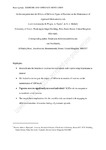An investigation into the effects of different types of exercise on the maintenance of approach motivation levels
| dc.contributor.author | Lowenstein, JAS | |
| dc.contributor.author | Wright, K | |
| dc.contributor.author | Taylor, A | |
| dc.contributor.author | Moberly, NJ | |
| dc.date.accessioned | 2018-01-16T15:54:29Z | |
| dc.date.available | 2018-01-16T15:54:29Z | |
| dc.date.issued | 2015-10 | |
| dc.identifier.issn | 1755-2966 | |
| dc.identifier.issn | 1878-0199 | |
| dc.identifier.uri | http://hdl.handle.net/10026.1/10595 | |
| dc.description.abstract |
Background This study looked to investigate the interaction between exercise and approach motivation (AM) levels in a non-clinical sample as a first step towards investigating the impact of acute exercise upon hypomanic states within Bipolar Disorder. The Behavioural Activation System (BAS) dysregulation theory proposes that AM levels in individuals with Bipolar Disorder, are hyper-reactive to relevant cues and prone to fluctuation such that excessive levels underpin hypomania/mania. We hypothesise that exercise may interact with high AM levels to further increase AM levels in both the general population and individuals with BD, with this effect being exacerbated in the latter group. As an initial test of this theory we explore the impact of moderate and vigorous exercise and sedentary activity upon AM in an unselected student sample. We also tested the extent to which hypomania vulnerability predicts the impact of exercise. Method Participants were recruited from a University student population. After completing a measure of hypomanic personality traits, 61 participants completed a task designed to induce higher levels of AM before taking part in one of three 15 min activities (sedentary, moderate exercise or vigorous exercise). AM levels as well as variables relevant to hypomanic symptoms were measured prior to and post AM induction, at 5 min intervals during the activities and twice during a recovery period. Results Vigorous exercise significantly increased individuals' AM levels in comparison to moderate or no exercise. No association was found between hypomania vulnerability and exercise impact. Conclusions These results provide a first step in investigating the possible risks associated with engaging in different intensities of exercise during a hypomanic episode. Any recommendations within this study should however be taken in light of the limitations identified. Further research replicating these results with a larger sample and among individuals with Bipolar Disorder is recommended. | |
| dc.format.extent | 24-34 | |
| dc.language | en | |
| dc.language.iso | en | |
| dc.publisher | Elsevier BV | |
| dc.subject | Bipolar disorder | |
| dc.subject | Behavioural activation system | |
| dc.subject | Behavioural approach system | |
| dc.subject | Approach motivation | |
| dc.subject | Exercise | |
| dc.title | An investigation into the effects of different types of exercise on the maintenance of approach motivation levels | |
| dc.type | journal-article | |
| dc.type | Article | |
| plymouth.author-url | https://www.webofscience.com/api/gateway?GWVersion=2&SrcApp=PARTNER_APP&SrcAuth=LinksAMR&KeyUT=WOS:000366962300004&DestLinkType=FullRecord&DestApp=ALL_WOS&UsrCustomerID=11bb513d99f797142bcfeffcc58ea008 | |
| plymouth.volume | 9 | |
| plymouth.publication-status | Published | |
| plymouth.journal | Mental Health and Physical Activity | |
| dc.identifier.doi | 10.1016/j.mhpa.2015.08.002 | |
| plymouth.organisational-group | /Plymouth | |
| plymouth.organisational-group | /Plymouth/Faculty of Health | |
| plymouth.organisational-group | /Plymouth/Faculty of Health/Peninsula Medical School | |
| plymouth.organisational-group | /Plymouth/REF 2021 Researchers by UoA | |
| plymouth.organisational-group | /Plymouth/REF 2021 Researchers by UoA/UoA03 Allied Health Professions, Dentistry, Nursing and Pharmacy | |
| plymouth.organisational-group | /Plymouth/Research Groups | |
| plymouth.organisational-group | /Plymouth/Research Groups/FoH - Community and Primary Care | |
| plymouth.organisational-group | /Plymouth/Research Groups/Institute of Health and Community | |
| plymouth.organisational-group | /Plymouth/Research Groups/Institute of Translational and Stratified Medicine (ITSMED) | |
| plymouth.organisational-group | /Plymouth/Research Groups/Institute of Translational and Stratified Medicine (ITSMED)/CCT&PS | |
| plymouth.organisational-group | /Plymouth/Research Groups/Plymouth Institute of Health and Care Research (PIHR) | |
| plymouth.organisational-group | /Plymouth/Users by role | |
| plymouth.organisational-group | /Plymouth/Users by role/Academics | |
| plymouth.organisational-group | /Plymouth/Users by role/Researchers in ResearchFish submission | |
| dc.identifier.eissn | 1878-0199 | |
| dc.rights.embargoperiod | Not known | |
| rioxxterms.versionofrecord | 10.1016/j.mhpa.2015.08.002 | |
| rioxxterms.licenseref.uri | http://www.rioxx.net/licenses/all-rights-reserved | |
| rioxxterms.type | Journal Article/Review |


